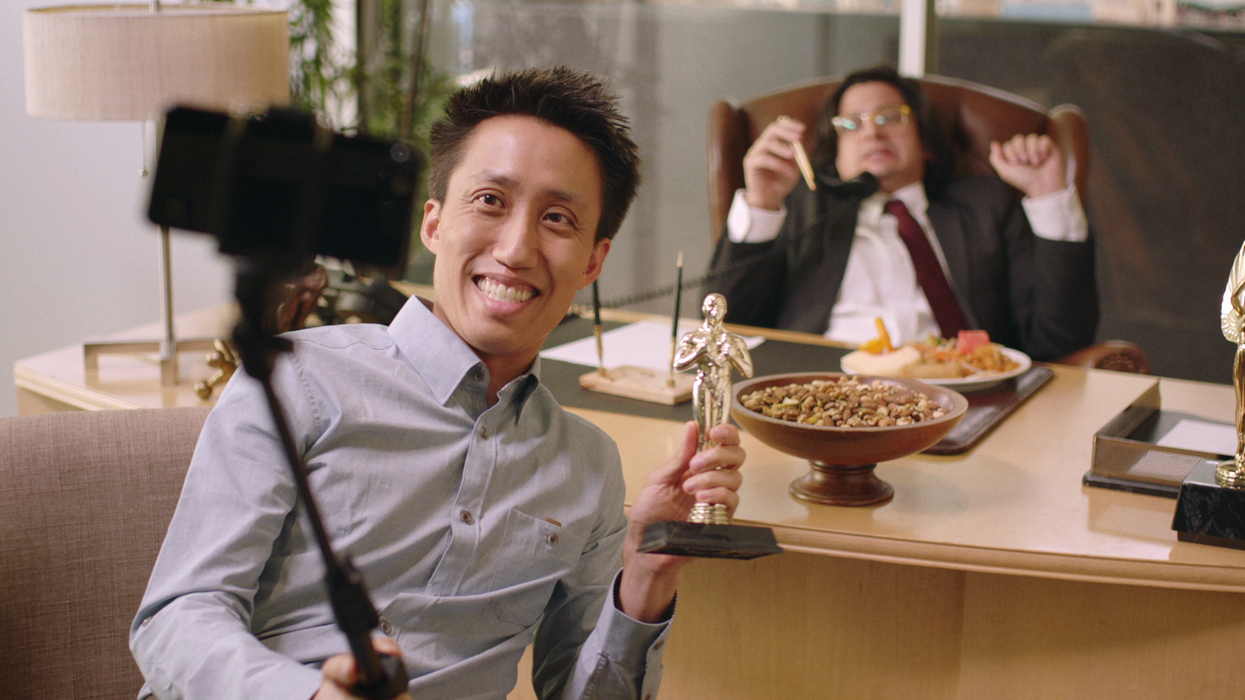Watch: How to Visualize Comedy with the Premiere of Web Series 'Ching Chong Blues'
What exactly separates your comedy from someone else's?

Asians are having a moment.
They weren’t in the summer of 2017, when Crazy Rich Asianswas just a twinkle in a Warner Brother’s eye and I was gearing up to direct the anthologized web series Ching Chong Blues. This was a few months after Scarlett Johansson’s Ghost in the Shell, half a year since the awkward email exchange between Margaret Cho and Tilda Swinton concerning her (formerly Tibetan, arguably whitewashed) role in Doctor Strange. Some folks were still reeling from Emma Stone in Aloha. The Asian community was atwitter with heated discussions about stereotypes, representation, and larger questions of Asian identity—topics that were absolutely long overdue.
My co-writer (and Ching Chong Blues star) Nelson Cheng and I wanted to be part of this conversation, but not in the vitriolic, torch and pitchfork manner that dominates the Reddit threads and comment sections of the interwebz. In the way that The Twilight Zone used speculative fiction to tackle the anxieties of the day, we dreamed of a show that would use dark, satirical comedy to tackle these rather unfunny issues. A few drafts later, we had three episodes ready to shoot.
With an anthologized web series that had episodes running seven-to-ten minutes in length, I was nervous about the show being written off as a series of sketches. That’s not a knock on sketches per se, as I love a good sketch (one of the big influences on our project was Chappelle’s Show), but we put a lot of effort into building out narrative arcs in these episodes, of thinking of each as a standalone short film. I still thought of this project as “cinema” and didn’t want that to get lost in the shuffle.
I also was afraid of people missing the humor. As the show treads into uncomfortable racial territory, how could I remind people that this was meant as satire, to provoke critical thought as well as elicit (uncomfortable) laughter? Check out the first episode (and my answer) below.
The answer was the camera. To reject the pervasive notion that comedies don’t have to be visually interesting, and to use the cinematography to highlight the humor and visual tropes of other media and representations that we were critiquing.
My cinematographer, Hana Kitasei, and I constantly looked for opportunities to incorporate visual humor, poring over a range of references including the kinetic comedy of Edgar Wright, the long takes of Albert Brooks, and cliches from campy martial arts movies. We also rewatched Tony Zhou and Taylor Ramos’ Every Frame a Painting episodes on Jackie Chan, Buster Keaton, and Wright, each of which I recommend to anyone remotely interested in visual comedy.
We were really interested in embracing the visual language of comedy.
I think you can see a lot of those influences in this first episode, “Rickshaw to Hollywood” and I feel particular pride for the way Johnny Wong appears in the frame just as he begins to harass the festival programmer Dana Liang, the way that Johnny meticulously coaches his actress in her kung fu moves against a brick wall, only to run into a bystander entering a nearby bathroom...
It’s definitely not complicated stuff, sight gags originated by Chaplin, Keaton, and the like, but with the persistent philosophy in Hollywood comedies that directors should just lock off the camera, let the actors riff, and then slap it together in the editing room, we were really interested in embracing the visual language of comedy.

We also used the camera to satirize Johnny’s pretentious, Caucasian-centric films. While we shot each episode of Ching Chong Blues on an Arri Amira, we used a combination of Sony A7s and Sony A6000 to shoot Johnny’s films-within-the-film, trying to amp up the amateur quality of his films through dramatic lighting and having Johnny’s films inhabit the stereotypical budding-filmmaker genres (black-and-white “arthouse,” low-budget sci-fi, porn-y sex drama).
I see every project as a learning experience, and this episode in particular posed some new challenges for me: the crowd scene, the dog scene, the fight scene (even an intentionally janky one!) were all terrifying and tricky to execute in different ways. If I were to do it again, I might spend a bit more time (read: any time) rehearsing the longer one-take dialogue scenes, and I would have tried to wrangle more extras than I could ever dream of using.
Is this a lasting change that will bring more Asian-American representation and stories, or will “Asian August” come and go?
Overall, I’m extremely pleased with “Rickshaw to Hollywood,” as I am with the other episodes of Ching Chong Blues that we’ll be releasing digitally throughout the Fall. We screened the project last May at the Los Angeles Asian Pacific Film Festival, where my fears were assuaged. People seemed to find it funny and infuriating in equal measure, which were my hopes exactly!
Where does “Rickshaw to Hollywood” fit in a post-Crazy Rich Asians media landscape, in which execs seem suddenly interested in “new voices, yellow faces?" Is this a lasting change that will bring more Asian-American representation and stories, or will “Asian August” come and go? I don’t present “Rickshaw” as some kind of cynical, arms-crossed “we’ll see” sort of thing. I genuinely feel optimistic about the future.
I hope that this episode will remind Asian American filmmakers to stick to their guns, even when the temptations of money, fame, and influence come calling.











